Physical hardware
When you spin up a cloud server, you think in number of (virtual) CPU cores and GB of RAM but the physical specifications of the underlying hardware are important – not all virtual cores are equal!
Fasthosts have built their CloudNX platform on enterprise-grade physical hardware. Each VPS I’ve used in the last 3 years has run on an Intel Xeon Gold CPU.
My first VPS in 2019 used a Gold 5120 – a CPU that Intel released in 2017. The VPS running this site now is on a Gold 6230R CPU, which Intel released in January 2020 – less than 2 years ago (at the time of writing). This proves that Fasthosts invest regularly in their hardware.

By comparison, some public clouds and smaller providers still use Xeon E3s, some of which are 10 years old!
Also unlike other public clouds, Fasthosts do not provision their VPS storage local to the hypervisor. Instead, the CloudNX platform stores virtual disks on a SolidFire NAS which uses all-SSD disks.
This ensures rapid performance and allows your VPS to run on an alternative physical server if one develops an issue.
It should be worth noting these statistics are as viewed by the hypervisor, rather than within your VPS’ operating system. You cannot monitor disk space in this way, for example, because the hypervisor cannot “see into” your VPS itself.
If you use Linux, you can monitor onboard statistics from within your VPS’ operating system – and set up alerts, such as low disk space, using my NodeBeagle Linux systems management tool.
CloudNX architecture
Fasthosts have architected CloudNX (the underlying platform that runs the VPS product) to be fault-tolerant and redundant. They back this up with a 99.999% uptime guarantee.
Fasthosts can live-migrate your VPS between physical servers thanks to the use of the SolidFire NAS instead of local storage. This is evident when Fasthosts upgrade the VMware software running the VPS – there is no interruption to service despite the hypervisor version changing.
If the physical server running your VPS develops an issue, Fasthosts can live-migrate it, or bring it up on another physical server with minimal downtime, as the operating system and data stored on its virtual disk are physically stored on a central NAS device.
CloudNX is also segregated into Availability Zones within each data centre. An Availability Zone (AZ) is an isolated environment that is plugged into the core network in the DC.
Should an equipment failure occur within AZ1, for example, this should not impact servers within AZ2.
You can read more about CloudNX architecture over on the Fasthosts’ blog.

Whilst VPS can be spun up in different AZs behind the scenes, customers don’t have control or visibility of this. This is one of the benefits of using CloudNX directly instead. You can choose which AZs your cloud servers are spun up in, helping you design high-availability applications that are less likely to fail.
Guaranteed 99.99% Uptime
Through the CloudNX architecture, enterprise-grade hardware and the latest operating systems for your VPS, Fasthosts promise 99.999% uptime. This looks good in theory, but is it achievable in practice?
The short answer is: yes. You can check out the last 60 days of uptime for my VPS on my status page.
At the time of writing, Fasthosts have achieved 100% uptime.


Add new comment